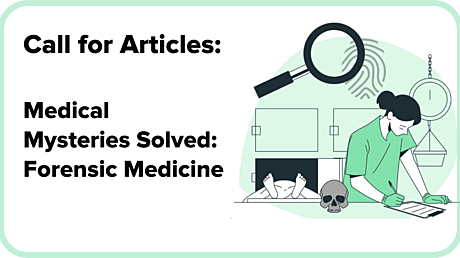Newsroom
Keynote on-demand webcast: Spotlight on Diet and Diabetes
Watch Springer Medicine's expert-led, on-demand webcast on the prevention and management of type 2 diabetes through dietary interventions, with an exploration of the psychological factors that influence patient success. Starting with the recent EASD guidelines, experts discuss weight management, including use of therapeutic diets, food types and processing, environmental sustainability, the psychological drivers of healthy eating and diabetes control, and the potential of new technologies to support diet adherence.
Nov 27, 2023
Cureus December 2021 Newsletter
Hi, You may have noticed an email (or two or three) alerting you that your published Cureus article has been assigned a new SIQ score. This is all part of our push to keep you in the loop regarding your published work. Remember, the discussion shouldn't stop after publication!
Nov 27, 2023
Cureus November 2021 Newsletter
Hi, Did you know that we're building a library of content on our new YouTube channel? Subscribe now and discover instructional surgical procedures and technique, immersive anatomy videos via 360 degree VR stereoscopic renderings, video abstract summaries, and more!
Nov 27, 2023
Call for Submissions: Nutritional Neurology & Psychiatry - The Gut-Brain Axis
An increasing body of evidence points to a bidirectional interaction between the gut and the brain, mediated by the microbiome, immune system, and other pathways. This gut-brain axis has been implicated in everything from anxiety and depression to Alzheimer's and Parkinson's disease. Cureus requests original research, review articles, technical reports, and case reports elucidating the role of diet, nutrition, probiotics, and the microbiome in neurological and psychiatric conditions. Published articles on this topic will benefit from our unparalleled platforms for dissemination. Our expansive reach across digital channels ensures maximum exposure and impact. To amplify these articles, Cureus will promote them to a wide audience of medical professionals through our social media channels, a dedicated email campaign, and article roundups. Example topics include: Irritable Bowel Syndrome: Treating the Gut and Brain/Mind at the Same Time Gut Biome and Mental Health: Do Probiotics Work? Connecting the Dots: The Interplay Between Stroke and the Gut-Brain Axis Abdominal Migraines: A Rare Adulthood Manifestation of a Typical Childhood Disease Diet Quality and Mental Health Amongst Acute Inpatient Psychiatric Patients Fecal Microbiota Transplantation Role in the Treatment of Alzheimer's Disease: A Systematic Review Please include the keyword "Gut-Brain Axis" in your submission. Submission Deadline: November 17, 2023 We welcome submissions from neurologists, psychiatrists, gastroenterologists, nutritionists, internists and other experts on this fascinating area of research with major clinical implications.
Oct 04, 2023
Call for Submissions Complete: AI and Robotics in Healthcare
We are living through a time of unprecedented innovation and advancement in the realm of artificial intelligence (AI) and robotics. With these advancements, healthcare is undergoing revolutionary changes, bringing about new methodologies, challenges, and opportunities. In light of this evolution, Cureus is calling for submissions of articles focusing on the impact of AI, robotics, or both of these technological advancements in healthcare. How are either or both of these technologies reshaping diagnostics, treatments, patient care, or the medical profession at large? What are the ethical implications, challenges, or limitations faced? How might we anticipate the role of these technologies in future healthcare scenarios? We invite physicians, medical practitioners, researchers, engineers, and others working in this fascinating intersection of technology and health to share their insights, experiences, and findings. We will consider: Original Research Review Articles Technical Reports Case Reports Editorials Example topics could include but are not limited to: The Use of AI in Diagnosing Diseases: Present and Future Robotics in Bariatric Surgery: Benefits, Limitations, and Challenges How AI and Robotics are Improving Patient Care and Experience AI in Medical Imaging: Opportunities and Concerns Ethical Implications of AI and Robotics in Healthcare To be included in this collection, please add the keyword "AI & Robotics in Healthcare" to your submission. All submissions will be featured on our email campaign and newsroom page. We eagerly anticipate your contributions as we navigate and comprehend the impact of AI and robotics in the ever-evolving landscape of healthcare.
Sep 27, 2023
Call for Submissions - Medical Forensics: True Crime Meets Medicine
The application of medical and scientific expertise to analyze crimes and establish facts in legal cases has long fascinated the public. From determining cause of death and time since death to toxicology testing and DNA analysis, medical forensics provides critical evidence in criminal investigations. Cureus requests original research, review articles, and technical and case reports exploring all aspects of forensic medicine and its role in the justice system. Please include the keyword "Forensic Medicine" in submissions. Submission Deadline: November 10, 2023 Example topics include: ABO Blood Grouping and Rhesus Factor Determination From Dental Pulp Tissue: A Forensic Research Blood-Based Biomarkers in Traumatic Brain Injury: A Narrative Review With Implications for the Legal System Homicide-Suicide Partners: A Simulation of Injuries Estimation of Time Since Death From Potassium Levels in Vitreous Humor in Cases of Unnatural Death: A Facility-Based Cross-Sectional Study The Use of Volatile Substances in Drug-Facilitated Sexual Assault: A Systematic Review This call welcomes articles from forensic pathologists, psychiatrists, odontologists, toxicologists, dentists, DNA analysts, and other experts on the complex intersection of medicine, science, and criminal justice. Published articles will be promoted through our social media channels, a dedicated email campaign, and article roundups, ensuring maximum impact and exposure to a wide audience of medical professionals. Share your work on this ever-intriguing field!
Sep 25, 2023
Call for Submissions - Advances in Rheumatic Disease Treatments
Rheumatic and musculoskeletal diseases such as rheumatoid arthritis, lupus, and osteoarthritis affect millions of patients worldwide. While often chronic and debilitating, recent years have brought exciting advances in pharmacological treatments and non-pharmacological therapies. Cureus requests original research articles, review articles, technical reports, and case reports that explore novel therapeutic approaches and agents for rheumatic disease management. We aim to provide clinicians with cutting-edge insights into optimized care for this complex patient population. Please include the keyword "Rheumatic Diseases" in your submission. Example topics include: Impact of SARS-CoV-2/COVID-19 on Provision of Medical Care to Patients With Systemic Autoimmune Rheumatic Disease and the Practice of Rheumatology Pathophysiology, Diagnosis, and Management of Takayasu Arteritis: A Review of Current Advances Oral Microbiome in Pre-Rheumatoid Arthritis: The Role of Aggregatibacter Actinomycetemcomitans in Bacterial Composition Dairy Consumption: Does It Make an Impact on Self-Reported Disease Activity of Inflammatory Arthritis? Submission Deadline: October 31, 2023 Published articles will be promoted through our social media channels, a dedicated email campaign, and article roundups, ensuring maximum impact and exposure to a wide audience of medical professionals. Don’t miss this opportunity to share your work on the future of rheumatology.
Sep 05, 2023











